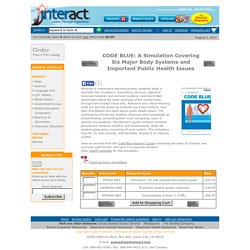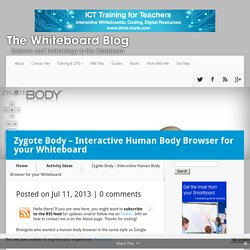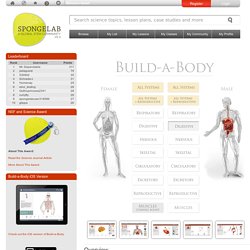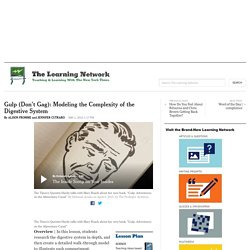

The Biology Corner. This worksheet provides steps for identifying structures of the grasshopper, with a focus on the external anatomy and mouthparts.

The lesson can be part of a larger unit on insects … In animals, form and function are closely related. This concept is illustrated very simply by looking at a variety of bird species where the shape of the beak and … Instructions include how to identify crayfish mouthparts, eyes, and appendages. Students can follow up with a dissection to reveal the internal anatomy. Students investigate what happens to the respiration rate of a fish as the temperature is increased and decreased; includes directions, data table and analysis. Students examine the symptoms of a newborn baby who has a problem with his heart and suggest treatment options. Worksheet provides instructions for dissecting an earthworm, starting with external anatomy and then locating internal structures, like the crop and gizzard.
Anatomy & Physiology. Anatomy & Physiology. Biology. Earth - The making of me and you. This story is part of BBC Earth's "Best of 2016" list, our greatest hits of the year.

Browse the full list. • Bill Gates is actually worth $1,956• Canadian pop star Justin Bieber has five times fewer cells in his brain than in his liver• Top tennis player Serena Williams has 24.5 trillion red blood cells powering her body• Internet and social media pioneer Mark Zuckerberg’s body contains 800MB of data• President Barack Obama’s head rules his heart; his brain weighs 1.4kg, his heart just 0.4kg Welcome to The Making of Me and You, a unique, new digital interactive from BBC Earth that details extraordinary personalised facts.
Just input your date of birth, sex at birth, height and weight, and choose the metric or imperial units that make most sense to you. CODE BLUE: A Simulation Covering Six Major Body Systems and Important Public Health Issues - Interact Simulations. Working in cooperative learning groups, students study a specialty-the circulatory, respiratory, nervous, digestive, muscular/skeletal, and immune systems—and teach their teammates about the inner workings of the human body through self-created visual aids.

Research and critical-thinking skills are put into action as students use Code Cards to "see" their first patient and learn about public health issues. The culminating activity has students showcase their knowledge at Grand Rounds, presenting their most compelling cases to parents and students. The teacher's guide contains complete procedures, handout masters, and assessments, while the student guide gives overviews of each system. The simulation runs for 15 class periods, with flexibility. Grades 5–8. View an excerpt from the Code Blue teacher's guide containing the table of contents and overview (pdf format; will open in a separate window)View related websites for this simulation. The Human Body by Tinybop on the App Store. Teacher Resources — N-Squad - About The Game. About The Game Students work with forensic scientists to solve an alcohol related crime.

Along the way, they will learn about alcohol's interaction in different body systems: digestive, circulatory, and nervous. About The Game Students work with forensic scientists to solve an alcohol related crime. Along the way, they will learn about alcohol's interaction in different body systems: digestive, circulatory, and nervous. Human Body: Explore the Human Anatomy in 3D. Code Fred: Survival Mode. Trauma. Zygote Body - Interactive Human Body Browser for your Whiteboard.
Biologists who wanted a human body browser in the same style as Google Earth, Google Sky, Google Moon etc got very excited a few years ago when Google brought out its Body Browser.

They then got sad when Google retired it. Well it looks like it’s back (sort of) under new management and is now called Zygote Body. But it looks exactly the same as it did when it was Google Body, which is great. Zygote Body gives you a fully-explorable 3D body. You can move about, zoom in, like you can in Google Earth. Double click on any organ to isolate it from the rest of the body. Build-A-Body. Overview Learn about the body's systems with this drag and drop game.

Choose organs from the organ tray, and place them in their correct position within the body to create organ systems. Build-A-Body is a drag and drop game where players are tasked with assembling an organ system from a set of organs. Players may then attempt case studies where a functional problem with a system must be linked to the organ affected. Our-human-body-classroom-1-13. Log In. Video The Times’s Quentin Hardy talks with Mary Roach about her new book, “Gulp: Adventures on the Alimentary Canal.”

Overview | In this lesson, students research the digestive system in depth, and then create a detailed walk-through model to illustrate each compartment.Materials | Computers with Internet access, projection equipment, an assortment of art supplies (butcher paper, fabric, yarn, cardboard, colored paper, tissue paper, paints, markers, glue, staplers, tape, scissors, etc.) Warm-up | When students arrive, project “Gulp! The Quiz” at the front of the room. If you have enough workstations for students to complete the quiz in pairs, have students pair up to take the quiz. When you have finished, lead a short discussion to debrief the quiz. Did any of the answers surprise you? Ask students to think about why they may find this topic funny, gross or uncomfortable as you then play the video “The Inside Scoop on Your Insides.” When the video has finished, ask: Reading 1. Writing: 8. 2nd Biannual NGSS STEM Education Conference.
Download the conference schedule and a map Session 1 Arms & Arteries: Adventures in Biomechanical Engineering.

NIH Curriculum Supplement Series for Middle School - Looking Good, Feeling Good: From the Inside Out - Exploring Bone, Muscle, and Skin. : BioMath. Quorum Sensing: Organisms Communicating and Coordinating We live in an ever-changing world.

Many people crave information about those changes. As a result, new means of communicating are continually evolving. People originally relied on word of mouth. With the invention of the printer, newspapers spread information to more people, more quickly. 01 A&P Resource Links. Can You Save the Princes & Princesses? Can You Save the Princes & Princesses? Disease and Disruption of Homeostasis. Curriculum Division / HS Anatomy/Physiology.
Throughout this comprehensive laboratory course, students will explore the human body in an in-depth study of human structure and function.

The course objective is to learn about the human body using verbal, visual, experimental, and written strategies. It will include facts about the structure of cells, tissues, and organs and their interaction with each other as the person lives, works, and dies. All systems of the human body are described in their roles in making up the human body. Students will examine current biological health issues using appropriate and effective reading and writing strategies which will be integrated into all aspects of the curriculum along with a comprehensive laboratory experience. This laboratory course covers all of the clear learning targets as outlined by Ohio’s New Learning Standards for Science and Common Core State Standards of English Language Arts & Literacy in History/Social Studies, Science and Technical Subjects.
Anatomy-Physiology.pdf. High School. > Human Body Activities and Games Free Downloads. > Anatomy T-shirt. Target age group: ages 7-12 Purpose of activity: To review general information about internal organs Description of activity: Patterns are provided so that you can either draw this design yourself or you can take the design to a T-shirt print shop and get it professionally printed onto a shirt. > Body Bingo.
Skin and Body Membranes. Skeletal System. Muscular System. Nervous System. Special Senses. Endocrine System. Blood and the Cardiovascular System. Lymphatic System and Body's Defenses. Respiratory System. Digestive System and Body Metabolism. Urinary System. Reproductive System. Recommended Reading. Lesson Plans. The Biology Corner. HASPI Curriculum - Health and Science Pipeline Initiative. Human Body – Coloring Nature. OpenStax. Lesson Plans. Human Anatomy and Physiology. Interactive Media - The Virtual Labs Project at Stanford. Anatomy & Physiology.
920L Animal Testing Argument vs Persuasive Writing. BioInteractive Search Results. Lessons - Resources - Life Sciences Learning Center. LifeSciTRC.org - Life Science Teaching Resource Community. Untitled. Zygote Body - Interactive Human Body Browser for your Whiteboard. Anatomy and Physiology Learning Modules - CEHD - U of M. Life Sciences Outreach Program. The following resources were developed for classroom use by high school biology teachers who participated in MCB-HHMI Outreach's Summer 2009 "Experimental Biology and Multimedia Workshop". This year's topic was "Physiology". Keep in mind that lesson formats vary greatly because each was developed with a particular classroom in mind. All lessons align with state and national science standards as described within the lesson or in an accompanying file. Understanding Your BMI and Making Healthy Choices Catherine Erickson (Introductory Biology) Brain Development Cheryl Wilson (Advanced Biology)
Lessons Registration - Resources - Life Sciences Learning Center. 2nd Biannual NGSS STEM Education Conference. Petto DaVinci. McGraw-Hill Virtual Biology Lab. Lessons Registration - Resources - Life Sciences Learning Center. Curriculum-Anatomy and Physiology. Anatomy and Physiology Learning Modules - CEHD - U of M. Quiz Bowl and Timed Test were retired at the end of summer 2013. Quiz Bowl had always been buggy, as many people had pointed out, and it had become difficult to maintain. It also used technology that doesn’t work on a lot of newer computers or tablets. Timed test depended on a browser add-on that both Microsoft and Apple have encouraged users to remove for security concerns. For these reasons, we took these two quizzes down at the end of the month. Thanks to everyone who has shown support for them, and we hope you continue to use the other quizzes on this site!
Looking for the Image Bank? Teacher Resources — Virtual Clinical Trials - About The Series. About The Series Players use scientific methods and process skills as they learn the process for designing and conducting a trial, the underlying neuroscience behind the medical advances being tested, and the related careers involved. 2013 Interactive Media Award Virtual Clinical Trials received an Interactive Media Award for Outstanding Achievement. View award. Teacher Resources — N-Squad - About The Game. Human Body: Explore the Human Anatomy in 3D. Curriculum-Anatomy and Physiology.
Books and Films - Body Story (Discovery Channel) Trauma. Trauma-Worksheet.pdf.